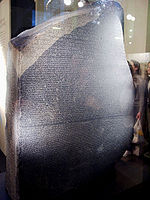- Decipherment of Egyptian hieroglyphs
-
 Demotic script on a replica of the Rosetta Stone.
Demotic script on a replica of the Rosetta Stone.
 The Rosetta Stone in the British Museum
The Rosetta Stone in the British Museum
The decipherment of Egyptian hieroglyphs was gradually achieved during the early nineteenth century. The most helpful clue was supplied by the discovery in 1799 of the Rosetta Stone, an inscription in two languages and three scripts. Building on work by several other scholars, notably Thomas Young, the breakthrough to decipherment was made by Jean-François Champollion.
The successful decipherment was preceded by a long period during which hieroglyphs were wrongly believed to be a purely ideographic script. In the fifth century appeared the Hieroglyphica of Horapollo, a spurious explanation of almost 200 glyphs. Authoritative yet largely false, the work was a lasting impediment to the decipherment of Egyptian writing. But whereas earlier scholarship emphasized Greek origin of the document, more recent work has recognized remnants of genuine knowledge, and casts it as an attempt by an Egyptian intellectual to rescue an unrecoverable past. The Hieroglyphica was a major influence on Renaissance symbolism, particularly the emblem book of Andrea Alciato, and including the Hypnerotomachia Poliphili of Francesco Colonna.
Later attempts at deciphering Egyptian hieroglyphs were made by Arab historians in medieval Egypt during the 9th and 10th centuries. By then, hieroglyphs had long been forgotten in Egypt, and were replaced by the Coptic and Arabic alphabets. Dhul-Nun al-Misri and Ibn Wahshiyya were the first historians to be able to at least partly decipher what was written in the ancient Egyptian hieroglyphs,[1] by relating them to the contemporary Coptic language used by Coptic priests in their time. Arabic manuscripts of Ibn Wahshiyya's work were later read by Athanasius Kircher in the 17th century, and then translated and published in English by Joseph Hammer in 1806 as Ancient Alphabets and Hieroglyphic Characters Explained; with an Account of the Egyptian Priests, their Classes, Initiation, and Sacrifices in the Arabic Language by Ahmad Bin Abubekr Bin Wahishih, contributing to the complete decipherment of hieroglyphs.[2]
The study of hieroglyphs continued centuries later, when various modern scholars attempted to decipher the glyphs, notably Johannes Goropius Becanus in the 16th century, Athanasius Kircher in the 17th, and Silvestre de Sacy, Johan David Åkerblad and Thomas Young in the early 19th century, each making one important step toward the solution but failing to find it.
Athanasius Kircher, a student of Coptic and Arabic, had read Ibn Wahshiyya's work in the 17th century and continued the study of hieroglyphs from where Ibn Wahshiyya had left off.[2] Kircher further developed the notion that the last stage of Egyptian could be related to the earlier Egyptian stages. Because he was not able to transliterate or translate hieroglyphs, however, he could not prove this notion.
The discovery in 1799 of the Rosetta Stone by Napoleon's troops (during Napoleon's Egyptian invasion) provided the critical information which allowed Jean-François Champollion to discover the nature of the script by the 1820s:
- It is a complex system, writing figurative, symbolic, and phonetic all at once, in the same text, the same phrase, I would almost say in the same word [3][page needed]
References
- ^ Dr. Okasha El Daly (2005), Egyptology: The Missing Millennium: Ancient Egypt in Medieval Arabic Writings, UCL Press, ISBN 1844720632. (cf. Arabic Study of Ancient Egypt, Foundation for Science Technology and Civilisation.)
- ^ a b Dr. Okasha El Daly, Deciphering Egyptian Hieroglyphs in Muslim Heritage, Museum of Science and Industry in Manchester.
- ^ Jean-François Champollion, Letter to M. Dacier, September 27, 1822
See also
Ancient Egypt Outline · Index
Architecture · Art · Burial customs · Chronology · Cuisine · Dynasties · Geography · History · Literature · Mathematics · Medicine · Military · Music · Religion · Pharaohs (list) · People · Language · Sites · Technology · Writing
Egyptology · Egyptologists · Egyptian MuseumPortal · List of major topicsWriting systems Overview Lists Types Categories:- Egyptian languages
- Egyptian hieroglyphs
Wikimedia Foundation. 2010.
